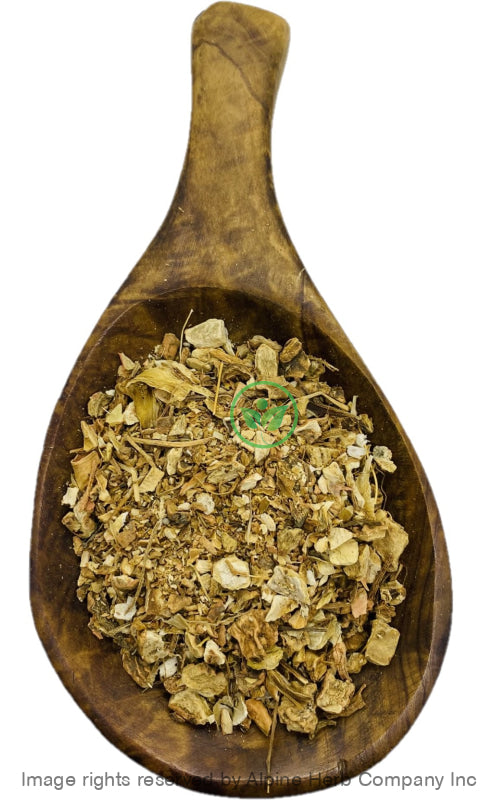Orris Root Cut Alpine Herb Company Inc.
$ 16,99 $ 10,19
Botanical Name: Iris germanica
Common Name:
- English: Orris
- Ayurvedic: Paarseeka Vachaa, Haimavati, Shveta Vachaa, Baal-bach.
- Also, known as: Orris, Iridis Rhizome, German Iris, Blue Flag, Daggers, Flag, Flaggon, Flag Lily, Fliggers, Florentine Iris, Gladyne, Iris, Iris d’Allemagne, Iris de Florence, Iris florentina, Iris germanica, Iris des Jardins, Iris junonia, Iris pallida, Jacob’s Sword, Lirio Azul, Liver Lily, Myrtle Flower, Poison Flag, Rhizoma iridis, Segg, Sheggs, Snake Lily, Water Flag, White Dragon Flower, Wild Iris, Yellow Flag, Yellow Iris
Origin: Albania
Harvested: Wild or cultivated
Parts Used: Root
General Information:
Iris germanica, commonly called common flag or German iris, is the presumed father of most modern bearded iris cultivars. There are some 300 species in the genus Iris. The most familiar irises are at least 28 inches tall bearded irises; Iris germanica. Origin is uncertain, but species plants are probably native to southern Europe and the Mediterranean area. In general terms, plants grow 2-3′ tall with sword-shaped linear leaves and large usually fragrant blooms on stalks that branch below their mid points. Basal leaves are stalkless, 25-75 cm long, smaller than stem leaves. Blade sword-shaped, with entire margin, parallel veined, usually slightly greyish green. The distinctive flowers are perianth regular, dark purple–pale blue; sometimes red, yellow or white, 10-15 cm wide; petals 6, in 2 separate whorls. Outer petals 3, curving downwards called “falls”; inner petals 3 called “standards”, same length as inner petals, broadly obovate, erect. The falls may have beards or crests. Bearded iris is so-called because they have soft hairs along the center of the falls. Flowers are fragrant. In crested iris, the hairs form a comb or ridge. It spreads by creeping rhizomes which form large clumps over time. Thousands of bearded iris cultivars in a rainbow of different colors have been introduced over the years, with cultivars now classified into several different types.
How to use:
Decoctions are suitable for roots, barks, large seeds & berries, and other dense material. The simple way to make decoction is, in a saucepan, add 1 tablespoon of dried herbs to 1 cup of water. Bring the water to boil, reduce heat and simmer for 30-60 minutes. Strain and squeeze out as much as liquid as possible and enjoy!
Tips:
- You can sweeten your herbal decoctions with a bit of honey, natural fruit juice, stevia leaves powder and or licorice root powder.
Precautions:
You should consult with a qualified healthcare practitioner before using any herbal products, particularly if you are pregnant, nursing, or on any medications.
All information on this website is for educational purposes ONLY.
This information has not been evaluated by Health Canada.
This information is not intended to diagnose, treat, cure, or prevent any disease.
| Unit Size | 100g, 200g, 400g, 1kg |
|---|
Prompt shipping and expert packing
Thanks to our longstanding association with UPS FedEx DHL as well as other leading global carriers, we can offer a variety shipping options. Our warehouse staff is highly trained and will be able to pack your goods in accordance with our precise and exact specifications. Your items will go through an exhaustive examination before they will be securely packaged before being delivered. We ship to hundreds of thousands of customers daily in different countries. This is a sign of our determination to become the largest online retailer worldwide. Warehouses and distribution centers are located throughout Europe as well as in the USA.
Note that orders containing multiple items are processed according to the particular item.
We will thoroughly inspect all items ordered before shipping. Most orders are shipped within 48 hours. The delivery time will be between 3 and 7 working days.
Returns
The stock market is always changing. It's not entirely managed by us since we're involved with several entities, including the factory and the storage. Therefore, the actual inventory could fluctuate at any moment. Please be aware that it is possible that your order could be out of stock after you've placed your order.
Our policy lasts for 30 days. If it's been more than 30 days since the date you purchased your item We're sorry to say that we can't offer you a full exchange or refund.
You can only return a product if it is unused and still in the same state as when you received it. The item should be in the original packaging.


































